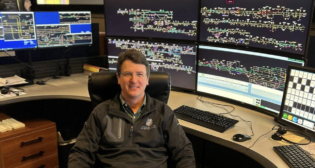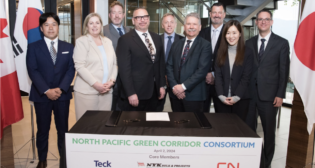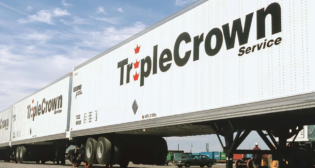
Why STB’s Inquiry Is a Public Service to Intermodal Shippers
Written by Jim Blaze, Contributing EditorJim Blaze takes a technical look at the Class I’s responses to the STB’s inquiry on intermodal from his experience dating back to 1968.
Railway Age readers can examine the Class I railroad CEO replies to Surface Transportation Board (STB) Chairman Marty Oberman (see links below), who requested that they provide information on the extent of congestion at key U.S. container terminals and on their railroads’ policies and practices for assessing container demurrage fees. Oberman cited reports of “substantial charges being levied by the railroads for container storage at these terminals.”
• BNSF to STB on ‘Maintaining Supply Chain Integrity During Periods of Heightened Volumes’
• CN to STB on ‘Policies that Promote Terminal Fluidity and Service Reliability’
• CP to STB on ‘Logistics Challenges Affecting Intermodal Shippers’
• CSX to STB on “an Efficient and Fluid” Intermodal Terminal Environment
• KCS to STB on ‘Managing Intermodal Operations Effectively’
• NS to STB on ‘Policies that Promote Terminal Fluidity and Service Reliability’
• UP to STB: ‘Clearing Our Network Will Take Some Time’
• AAR Warns STB About ‘Unintended Consequences’
My opinion/report is based on what could have been added for “more beef,” and why the STB inquiry is actually an important public service to rail intermodal customers.
Below is a selected commentary based on the individual “corporate” replies.
Let’s start by examining the Association of American Railroads (AAR) industry-wide response.
AAR says its members “have made clear in their own responses how they are collaborating with all stakeholders to keep intermodal terminals and the entire national rail network fluid,” and the STB “should refrain from any regulatory action that would undermine those efforts.”
As an economist, I ask: What does “refrain from” mean? Sounds litigious (but bear in mind it was written by an attorney). Is that appropriate as a response to a general information request from federal authorities? The requesting letter was obviously a timely series of questions from the only public authority charged with rate and service oversight (as opposed to safety) over the rail freight sector. Nothing in the request appeared threatening, did it?
Bottom line: AAR seems to be drawing a line in the sand that suggests STB follow the path of congressional policy articulated back around 1981-84. AAR cites a decision in Brae Corp. v. United States (D.C. Cir. 1984). That decision did affirm that the then-ICC (now STB) should favor deregulation where that oversight approach helps.
There is only one problem, for transportation professionals who may not have law degrees: This AAR view presumes that there is a well-defined national transportation policy and indeed a supporting plan. Many economists would argue that the nation’s policy and federal/state plans are not well-defined.
My interpretation is that AAR is taking a firm legal position to tell the STB that Congress has directed it to de-regulate intermodal. That’s okay. Yet at the same time, let’s agree that the STB ought not to be blind to its oversight role. Congress never excused it from such a responsibility. Right now, STB is asking the railroads for a self-appraisal report card that outlines what’s happening and what the railroads think they can do to contribute to a resolution. What’s wrong with that mission?
Here is the baseline in one slide that prompted the STB questions:
Why is performance along the railway portion of the complex intermodal chain suffering delays if in fact the traffic volume of international rail moved containers is slowing, and still less than 2018 and about even with 2019? It is a reasonable regulatory question, regardless of one’s view on less regulation than in the past (the real commercial meaning of deregulation). Deregulation is not the total absence of oversight, is it?
What are the respective railroads saying?
Here are this old railroader/intermodalist’s takeaways from the submitted corporate responses.
I’m finding key metrics that in some cases could be improved as reporting marks. I’m also seeing the need for a lot more of the long-promised movement visibility and digital sharing among multiple players, which are not yet being provided. The railroads’ responses are evaluated and presented in random order.
Inside BNSF’s Reply to STB
The BNSF summary tells a lot about the role of rail in the long, complex supply chain business model. BNSF testifies that it “does believe that there is enough physical capacity present across the national supply chain to handle current volumes.”
As evidence, BNSF has moved so far year-to-date “significantly more” intermodal containers and trailers than it did during the intermodal industry’s last peak year of 2018. That is true.
BNSF submits that “the amount of chassis, port and rail terminal capacity, rail equipment and employee resources is sufficient to handle the current volumes, but only if all parts of the supply chain do their part.” That is a pretty consistent argument in each of the submitted Class I replies to the STB. That logic is also consistent with similar observations made by Railway Age Contributing Editors.
BNSF President and CEO Katie Farmer states that everyone across these logistics chains should operate on a 24/7 intermodal service basis, just like BNSF does and the other six Class I railroads. Too many players—like some ports and other terminals—have too many shut-down business hours.
The final receiving customer has a key responsibility. BNSF is not the origination or the final destination of a load. Farmer correctly observes that BNSF has relatively few options to maintain the fluidity of BNSF intermodal terminals if containers are not picked up by customers on a timely basis.
What’s missing? To assist customers, BNSF needs to improve its digital TMS (Transportation Management System) data feeds with improved direct visibility from electronic tags and other near-real-time devices. But that is not happening in a robust manner yet in 2021, is it?
What’s the improvement timeline? That’s what the customers and STB are looking for. It’s a reasonable question to each of the responding railroads.
Ask yourself: Which of the responding railroad organizations answered that timeline question best?
BNSF offered a unique terminal-specific physical solution to the current crisis. As one example, at its Chicago-region LPC terminal, BNSF took out two 8,000-foot segments of terminal production track (where out-of-service trains are parked). The reason? To create more capacity to drop (“ground”) containers coming into this BNSF yard. BNSF in effect installed specialized mats over those two tracks to allow for the deramping and stacking of additional customer containers (see below).
Taking these two tracks out of service for parking trains allows BNSF to stack the equivalent of an additional 10 trains of grounded container yard inventory on the same footprint.
Realistically, it is not a long-term solution. It is not sustainable in a growth-focused long-term market plan.
Inside CN’s reply to STB
Despite the challenges in other parts of the supply chain, CN says that it has been investing, collaborating, communicating and driving creative initiatives that have enabled beneficial solutions to all participants within the supply chain. CN argues in its STB response that it is important for BCOs (Beneficial Cargo Owners), third-party logistics providers and ocean carriers to play their part as well.
CN admits to being movement-in-progress blinded. It admits that it is difficult for a railroad to devise solutions for congestion after it arises where the railroad has zero visibility to the forecast, pipeline and actual importer on record. CN’s rail intermodal terminals were not designed to perform as classical container holding yards for long-term storage.
Like most other railroads in North America, the urban-area rail intermodal yards have small footprints and often somewhat unusual land shape patterns. Many were never originally laid out for smooth future-year conversion to intermodal operations.
CN has been developing (as have some of the other Class I railroads) its own internally driven API- (application programming interface-) type data set monitoring and management applications. CN’s APIs enable system-to-system transmission of the last free day of storage, driving incremental visibility within customers’ planning systems through real-time digital connectivity. That data, CN reports, assists CN customers and third-party stakeholders (such as draymen) in optimizing their workload by focusing on first-in-first-out, potentially reducing dwell and supply chain costs.
That is CN’s unique approach to helping its customers and intermodal operating partners with improvements to intermodal automation. Translation in “business English” is this: CN’s intermodal terminals appear to use CN’s Shipment Status and third-party APIs.
The downside? Each intermodal customer (here, a CN customer) has to log onto each railroad’s unique data system. There is so far very little cross-industry data exchange for international intermodal container management. With so many players in the global container sector, that uniqueness of Company T platforms results in serious “factorial relationship” problems for the industry as a whole.
None of the railroads seem to be addressing that issue in their report cards to STB.
CN offers STB a possible solution. The railroad cites as creating intermodal capacity increases in its Prince Rupert train length by 20% during the first halfof 2021. But that is only a partial solution when so much of the current congestion is really at the inland terminals. That kind of a suggested solution might have to be somehow mathematically discounted.
CN also cites increased capacity to its East Coast ports like Halifax. That is a good press story during this crisis, but logically it was a separate marketing initiative before the pandemic struck. And Halifax rerouting might not actually directly benefit many U.S. inland terminal congestion points. Again, this argument might have to be discounted by STB.
Inside CSX’s reply to STB
CSX, and a few others, listed its daily delay fee schedules for containers left too long at its yards. For international containers at three high-daily-intermodal-volume locations, here are those fees CSX cites in its STB response:
- Days 1-7: $200 per day.
- Days 8 and longer: $500 per container day.
- In some peak periods, the fees can increase $100 for Days 2-7.
CSX argues that in some cases some receivers may choose to incur these demurrage charges rather than make investments or operational changes to avoid them. CSX correctly argues that “receivers have the right to make the economic choices that make sense for their businesses,” just as railroads have the right to use demurrage in a manner they feel minimizes the harm that excessive dwell can cause to the railroad, to other railroad customers, and to the global supply chain.
But at $500 per day, is that an excessive profit-making business model? After all, the daily rental (per diem) pricing of such units is very small compared with a $500 charge.
And is it true that CSX does this to directly improve the management of the global supply chain? That is a legitimate question, since CSX appears to admit that is has a too-limited role in international supply chains. And CSX seems to lack total supply chain visibility, particularly when containers are not on its property and in direct control as part of train operations.
To quote CSX senior management: “CSX does not engage in international supply chain management, nor do we provide steamship, port or drayage services, chassis assets, container storage depots, or warehousing. Short of limiting upstream port and vessel flows to inland markets, storage charges are the railroads’ principal tool for ensuring that shippers and receivers clear containers from our intermodal rail terminals …”
Inside KCS’s reply to STB
In a refreshing manner, Kansas City Southern (KCS) makes it simple for global players to use its intermodal rail services. For both customer-controlled and railroad-controlled equipment, the daily storage charge by KCS is $100 per day following the expiration of free time. The KCS fee does not change as additional chargeable days accrue. This KCS container delay charge has been in effect at least 10 years, the railroad notes in its STB response.
Why does KCS make it so simple? There are prudent limits to KCS’s long-yard-storage container plan. If intermodal equipment remains on KCS premises for more than 16 days, KCS will notify the consignor that the equipment needs to be removed immediately. If shippers do not respond, then KCS uses a unique Tariff KCS 6000-F approach and notifies them that equipment left on KCS premises more than 45 days is deemed abandoned.
Wrap-Up Comments
CP, Union Pacific (UP) and Norfolk Southern (NS) also responded with their self-composed report cards. I encourage you read them closely.
Here are this rail economist’s final remarks. The railroads seem to have congestion concentrated on only a few of their highest-volume terminals. Congestion and too high a storage rate seem to be avoided in their smaller daily volume intermodal yards. That pattern seems to be consistent whenever the railroad report cards contained a table or graph. That suggests plenty of room to handle more international container volumes, but that shifting hasn’t yet occurred—not if we closely examine those exhibits.
Here is the CP relevant table (as provided in its STB response) that shows storage volumes over time by terminal (U.S. only):
Here is NS’s exhibit to the STB of traffic changes at its principle international container yards (omitted are domestic U.S. container yards and their volumes, which were not requested by STB):
On NS, clearly Chicago and Atlanta (Austell Yard) stand out as large parking lots for containers.
Here is a Blaze takeaway: When you read these tables, or STB reads them, it would be helpful for the railroad to submit the yard-designed storage number as a key reference. It is not the absolute number or even the change from year to year that is critical. The strategic question is about the design target, in an age when railroads are touting their market growth outlook. The design standard clearly sets out the challenge to handle the asserted strategic long-promised intermodal growth.
Many of the challenged intermodal terminal footprints are going to require capex to achieve their market targets. These footprints have been ignored by many pundits. Without such capital yard investment, we could revisit this congestion problem again. Do you agree?
The yards cited in most of the railroad responses give a clear picture that there are clear variances as to where each railroad is seeing surging intermodal container volumes. But they lack the clarity that would come from simply identifying volume changes relative to the yard’s current daily design capacity.
Below is a table that shows the variance of changes over the past year (summer to summer period) by yard. Not all yards are shown here. This is just an example of the differences by market geography.
Following are the public policy and customer (shipper) questions that STB findings might shed light on:
- Which yard footprints are handicaps when it comes to supporting growth and traffic surges? The railroads haven’t shared their technical outlook on this subject. But customers and national policy thinkers should reasonably want to know. It’s a basic commercial inquiry. No need to panic yet about possible re-regulation.
- What role could improved direct-visibility GPS tracking and forecasting play in resolution of yard congestion? Is the solution going to be a railroad-by-railroad approach, or is it better given by third-party providers not hung up on proprietary database cultures?
- Can data visibility and forecasting “next supply chain handoff” tools (software) be delivered faster, in perhaps just two years’ time?
- How big a deal is demurrage income, particularly when an excessive (about $13,000) demurrage bill for a single 40-foot container could conceivably equal more than double the calculated purchase price of an all-new TEU container? Let’s look at this another way: At $200 to sometimes $300 per day, by how much does the railroad penalty charge exceed the per diem container rental? One example at $400 per day clearly seems “over the top.” Two to maybe three times might seem economically reasonable. But beyond that, such rates seem extreme.
- Finally, and maybe most important to railroad investors: How do such charges compare to trucking fees? This is important, since truckers dominate much of this distribution market. How do the railroads best market for growth and the promised (national-policy-presumed) market-mode shift toward rail if their charges are out of line with the truckers?
These are questions or hypothetical challenges, perhaps best handled in an open STB proceeding. Without an open airing, they’re more likely to result in unintended consequences.
Now, let’s hear your replies.
Independent railway economist and Railway Age Contributing Editor Jim Blaze has been in the railroad industry for more than 40 years. Trained in logistics, he served seven years with the Illinois DOT as a Chicago long-range freight planner and almost two years with the USRA technical staff in Washington, D.C. Jim then spent 21 years with Conrail in cross-functional strategic roles from branch line economics to mergers, IT, logistics, and corporate change. He followed this with 20 years of international consulting at rail engineering firm Zeta-Tech Associated. Jim is a Magna Cum Laude Graduate of St Anselm’s College with a master’s degree from the University of Chicago. Married with six children, he lives outside of Philadelphia. “This column reflects my continued passion for the future of railroading as a competitive industry,” says Jim. “Only by occasionally challenging our institutions can we probe for better quality and performance. My opinions are my own, independent of Railway Age. As always, contrary business opinions are welcome.”



